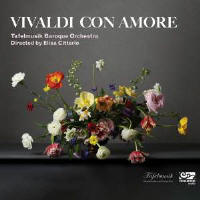Texte paru dans: / Appeared in: |
|
|
Reviewer:
Bertil van Boer
Recorded last year in Toronto,
this collection of solo works by Antonio Vivaldi shows that the venerable
ensemble Tafelmusik is alive and well. It is well known that the composer
was adept at writing for a variety of instruments, some conventional and
some lesser known. It is not entirely clear why this group has been chosen,
but one suspects that violinist and director Elisa Citterio meant for it to
show off her talents, given that three of the works are for solo violin, and
there is an extensive solo part in the Sinfonia to the opera Ottone in
Villa. The C-Minor Concerto (RV 761) begins rather furiously with almost a
dialogue in the ritornello, with the solo spinning out the sequences from
the lower to the upper registers. The Largo floats along thinly, while the
finale is almost Spanish it is decisive rhythmic structure. Here, the solo
has a rather complex line that remains mostly in the higher tones but with
some impressive double-stop work. The second concerto in E Major (RV 271),
nicknamed “L’amoroso,” is rather quite lilting, perhaps even a bit
insistent, while the second movement is an austere lament. The work ends
with a flurry of sequences. Of course, both the Lute Concerto (RV 93) and
Four-Violin Concerto are concert favorites, with the former better known for
its performance by the mandolin. Here, a pair of flutes provides the lighter
tone of the music. The latter of course has the opening fanfare of the
soloists tumbling all over each other before a more strict ritornello
heralds the various imitative effects. The finale with its rhythmic pace
consists of a series of scalar sequences that give the work an undulating
contour.
The other concertos are of the
multiple instrument variety that contrast both like and unlike instruments.
Sandwiched in between is the D-Minor Bassoon Concerto (RV 481) with its
manic opening and relentless rhythmic ostinato and solo Alberti bass. When
the solo instrument enters, it plumbs the entire range, but with some nice
lyrical sequences. The Larghetto is like an operatic statement, dramatic and
stoic, but with redeeming textures and suspensions. The solo line is a
gentle lyrical aria. The finale, however, practically explodes with energy,
like instrumental fireworks going off in sequence. Here the solo part is
almost at the point of playability. The duo concerto for oboes (RV 534) is
appropriately cheerful and lively, with the solos in parallel thirds and a
solid bassoon underpinning. At times, the oboes almost sound like trumpets
in their crisp and pointed lines. The Largo practically minces in small
motivic sequen-ces, while the finale is a raucous chase. The final work (RV
564a) pairs violins and oboes in a sort of double duet, allowing swirling
violin parts that sound like an outtake from The Seasons, and initially the
oboes play a secondary role mimicking the violins. The flowing Adagio
reflects a barcarolle in the melodic flow. Here the oboes are limited to
chords in between the violin solos. The final movement is a chase, and one
can almost hear the hounds as the instruments hunt each other. All of these works have been recorded before (though not all together, that I’m aware). The performance from the Tafelmusik is, as one might expect, polished and lively. The tempos are excellent for Vivaldi and one cannot faulty the intonation or phrasing. Citterio’s playing is technically proficient and musical, as are the other soloists drawn from the ensemble. As one would expect, this is a fine disc and shows that their reputation as one of the finest early music ensembles is fully justified. | |
|
|
|
|
|
|
|
Cliquez l'un ou l'autre
bouton pour découvrir bien d'autres critiques de CD |
|




